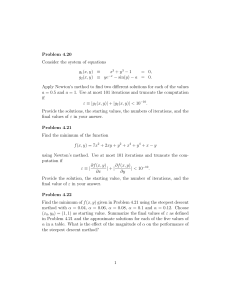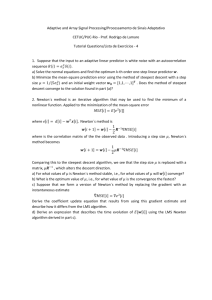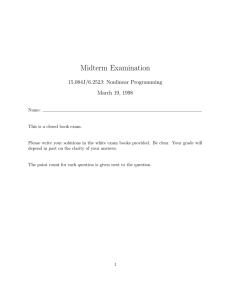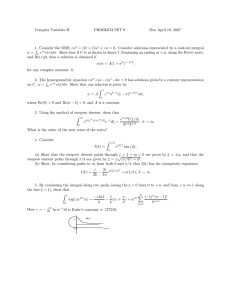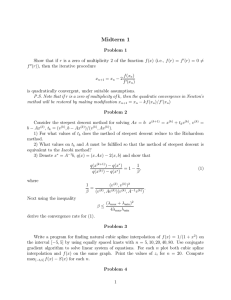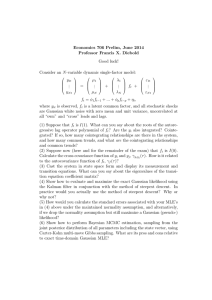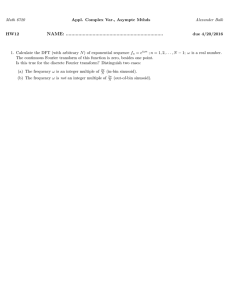Projection Methods for Linear Equality
advertisement
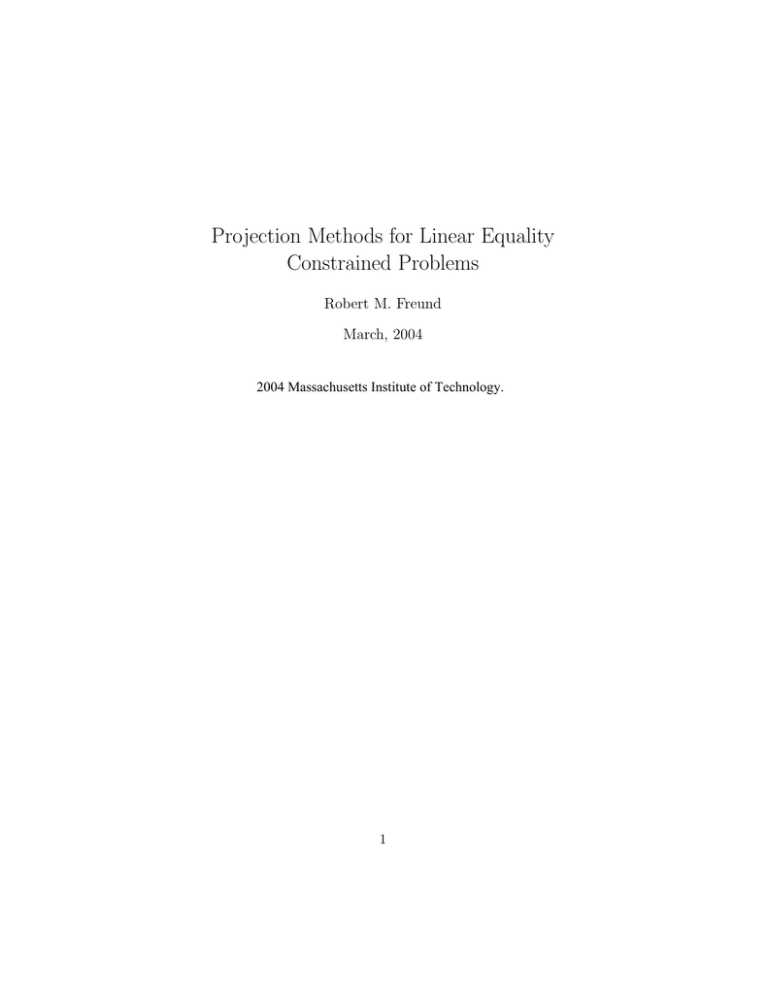
Projection Methods for Linear Equality
Constrained Problems
Robert M. Freund
March, 2004
2004 Massachusetts Institute of Technology.
1
1
Review of Steepest Descent
Suppose we want to solve
P : minimize f (x)
x ∈ n ,
s.t.
where f (x) is differentiable. At the point x = x̄, f (x) can be approximated
by its linear expansion
f (¯
x + d) ≈ f (¯
x) + ∇f (¯
x)T d
for d “small.” This leads to the choice of d dictated by the direction-finding
problem:
minimize ∇f (¯
x)T d
d ≤ 1,
s.t.
which is equivalent to:
minimize ∇f (¯
x)T d
dT Id ≤ 1.
s.t.
The solution to this direction finding problem is:
2
−∇f (x̄)
.
d¯ =
∇f (x̄)
Because we choose our next step as
¯ + αd¯
x = x
for some choice of step-length α, then we can re-scale the direction d¯ simply
as:
d¯ = −∇f (x̄).
That is, the steepest descent direction is simply the negative of the gradient of f (x) at x = x̄.
2
Equality Constrained Problems
Now consider the slightly more complicated problem
P : minimize f (x)
s.t.
Ax = b
x ∈ n ,
where f (x) is differentiable. The KKT conditions for this problem are as
follows:
Ax̄
= b
T
x) +A π
∇f (¯
¯ = 0.
3
We wish to find such a KKT point.
Suppose that we are at the point x = x,
¯ where A¯
x = b, i.e., x
¯ is a feasible
point. Again we have
f (¯
x + d) ≈ f (¯
x) + ∇f (¯
x)T d
for d “small.” In order to choose the direction d¯ and compute the next point
¯ + αd¯
x = x
for some stepsize α, we will solve the following direction-finding problem:
¯
x) + ∇f (¯
minimize f (¯
x)T (x − x)
s.t.
Ax = b
x − x̄ ≤ 1,
or equivalently (by setting d = x − x̄)
x)T d
minimize ∇f (¯
s.t.
Ad = 0
dT Id ≤ 1.
4
Note that Ad = 0 ensures that A(¯
x + αd) = A¯
x = b for any α. Also note
that the constraint “dT Id ≤ 1” says that d must lie in the Euclidean unit
ball B, defined as:
B = {d ∈ n | dT Id ≤ 1}.
However, the Euclidean ball is but one metric, and we might instead be
more general, and choose to restrict d to lie in an ellipsoid
EQ = {d ∈ n | dT Qd ≤ 1},
where Q is a given symmetric and positive-definite matrix. This leads to the
more general direction-finding problem:
minimize ∇f (¯
x)T d
s.t.
Ad = 0
dT Qd ≤ 1.
The projected steepest descent algorithm is:
Step 1. x
¯ satisfies A¯
x = b. Compute ∇f (¯
x).
Step 2. Solve the direction-finding problem (DFP):
DFP:
d¯ = arg minimum ∇f (¯
x)T d
s.t.
Ad = 0
dT Qd ≤ 1,
5
If ∇f (¯
x)T d¯ = 0, stop. In this case, x
¯ is a Karush-Kuhn-Tucker point.
x + αd¯) for the stepsize α,
¯ perhaps chosen by an exact
Step 3. Solve minα f (¯
or inexact linesearch.
Step 4. Set x
¯←x
¯ + αd.
¯ ¯ Go to Step 1.
Note that if Q = I and the equality constraints Ax = b are absent, this
algorithm is just the steepest descent algorithm.
3
Properties of the Projected Steepest Descent
Direction d¯
Note that DFP is a convex program, and d = 0 is a Slater point. Therefore, the Karush-Kuhn-Tucker conditions are necessary and sufficient for
optimality in DFP. These conditions are:
Ad¯ = 0
(1)
d¯T Qd¯ ≤ 1
(2)
¯ ¯= 0
¯ + 2βQd
∇f (¯
x) + AT π
(3)
β¯ ≥ 0
(4)
6
¯ ¯ = 0.
β̄(1 − dQd)
(5)
As it turns out, it is extremely easy to solve these equations. (We will
see this shortly.) Let d¯ solve the equations (1)-(5) with multipliers β¯ and π̄.
Proposition 3.1 x
¯ is a Karush-Kuhn-Tucker point of P if and only if
T
¯
∇f (x̄) d = 0.
Proposition 3.2 x
¯ is a Karush-Kuhn-Tucker point of P if and only if β¯ =
0.
Proposition 3.3 If x̄ is not a Karush-Kuhn-Tucker point of P , then d¯ is
a descent direction.
Proposition 3.4 The projected steepest descent algorithm has the same
convergence properties and the same linear convergence as the steepest de­
scent algorithm. Under the same conditions as in the steepest descent algo­
rithm, the iterates converge to a Karush-Kuhn-Tucker point of P , and the
convergence rate is linear, with a convergence constant that is bounded in
terms of eigenvalues identically as in the steepest descent algorithm.
4
Solving the Direction-Finding Problem (DFP)
Approach 1 to solving DFP: solving linear equations
Create the system of linear equations:
˜ = −∇f (¯
x)
Qd˜ + AT π
(6)
Ad˜ = 0
(7)
7
˜ π)
and solve this linear system for (d,
˜ by any method at your disposal.
If Qd˜ = 0, then
˜=0
∇f (¯
x) + AT π
and so x̄ is a Karush-Kuhn-Tucker point of P .
If Qd˜ = 0, then rescale the solution as follows:
d˜
,
d¯ = �
d˜T Qd˜
π
¯ = π,
˜
1
.
β¯ = �
2 d˜T Qd˜
¯ π,
¯ defined above satisfy (1), (2), (3), (4), and
Proposition 4.1 (d,
¯ β)
(5).
8
Note that the rescaling step is not necessary in practice, since we use a
line-search.
Approach 2 to solving DFP: Formulas
Let
P = [Q−1 − Q−1 AT (AQ−1 AT )−1 AQ−1 ]
�
β¯ =
(∇f (¯
x))T P (∇f (¯
x))
2
x))
π
¯ = −(AQ−1 AT )−1 AQ−1 (∇f (¯
If β¯
> 0, let
−P (∇f (¯
x))
.
d¯ = �
x))T P (∇f (¯
(∇f (¯
x))
If β¯
= 0, let d¯ = 0.
Proposition 4.2 P is symmetric and positive semi-definite. Hence β¯ ≥ 0.
¯ π,
¯ defined above satisfy (1), (2), (3), (4), and
¯ β)
Proposition 4.3 (d,
(5).
9
5 Modification of Newton’s Method with Linear
Equality Constraints
Here we consider the following problem:
(P:)
minimizex
s.t.
f (x)
Ax = b.
Just as in the regular version of Newton’s method, we approximate the
objective with the quadratic expansion of f (x) at x = x̄:
˜ :)
(P
x) + ∇f (¯
x)T (x − x)
¯ + 12 (x − x)
¯ t H(¯
x)(x − x)
¯
minimizex h(x) := f (¯
s.t.
Ax = b.
Now we solve this problem by applying the KKT conditions, and so we
solve the following system for (x, u):
Ax
= b
∇h(x) +AT u = 0 .
Now let us substitute the fact that:
x) + H(¯
∇h(x) = ∇f (¯
x)(x − x)
¯ and A¯
x = b.
10
Substituting this and replacing d = x − x̄, we have the system:
Ad
= 0
x) .
H (¯
x)d +AT u = −∇f (¯
The solution (d, u) to this system yields the Newton direction d at x̄.
Notice that there is actually a closed form solution to this system, if we
want to pursue this route. It is:
�
d = −H(¯
x)−1 ∇f (¯
x)−1 AT AH (¯
x) + H (¯
x)−1 AT
�
x)−1 AT
u = − AH (¯
�−1
�−1
AH(¯
x)−1 ∇f (¯
x)
AH(¯
x) .
x)−1 ∇f (¯
This leads to the following version of Newton’s method for linearly constrained problems:
Newton’s Method for Linearly Constrained Problems:
Step 0 Given x0 for which Ax0 = b, set k ← 0
¯ u):
¯
¯ ← xk . Solve for (d,
Step 1 x
Ad¯
= 0
¯ = −∇f (¯
x) .
H (¯
x)d¯ +AT u
If H(¯
x)d¯ = 0, then stop.
Step 2 Choose step-size αk = 1.
¯ k ← k + 1. Go to Step 1.
Step 3 Set xk+1 ← x
¯ + αk d,
11
(8)
Note the following:
• If H(¯
x)d¯ = 0, then x
¯ is a KKT point. To see this, note from Step 1
T
¯ = 0, which are precisely the KKT conditions for
that ∇f (¯
x) + A u
this problem.
• Equations (8) are called the “normal equations”. They were derived
presuming that H(x̄) is positive-definite, but can be used even when
H (x̄) is not positive-definite.
• If H (x̄) is positive definite, then d¯ is a descent direction. To see this,
x)T d¯ = −d¯T H (¯
note that ∇f (¯
x)d¯ < 0 from (8) since H(¯
x) is positive
definite.
6
The Variable Metric Method
In the projected steepest descent algorithm, the direction d must lie in the
ellipsoid
EQ = {d ∈ n | dT Qd ≤ 1},
where Q is fixed for all iterations. In a variable metric method, Q can
vary at every iteration. The variable metric algorithm is:
Step 1. x
¯ satisfies A¯
x = b. Compute ∇f (¯
x).
Step 2. Choose a postive-definite symmetric matrix Q. (Perhaps Q = Q(x̄),
i.e., the choice of Q may depend on the current point.) Solve the directionfinding problem (DFP):
12
DFP:
d¯ = arg minimum ∇f (¯
x)T d
s.t.
Ad = 0
dT Qd ≤ 1,
¯ is a KKT point.
x)T d¯ = 0, stop. In this case, x
If ∇f (¯
Step 3. Solve minα f (¯
x + αd¯) for the stepsize α,
¯ perhaps chosen by an exact
or inexact linesearch.
Step 4. Set x
¯←x
¯ + αd.
¯ ¯ Go to Step 1.
All properties of the projected steepest descent algorithm still hold here.
Some strategies for choosing Q at each iteration are:
• Q=I
• Q is a given matrix held contstant over all iterations
• Q = H(x̄) where H (x) is the Hessian of f (x). It is easy to show
that that in this case, the variable metric algorithm is equivalent to
Newton’s method with a line-search, see the proposition below.
• Q = H(x̄) + δI, where δ is chosent to be large for early iterations,
but δ is chosen to be small for later iterations. One can think of this
strategy as approximating the projected steepest descent algorithm in
early iterations, followed by approximating Newton’s method in later
iterations.
13
Proposition 6.1 Suppose that Q = H(x̄) in the variable metric algorithm.
Then the direction d¯ in the variable metric method is a positive scalar times
the Newton direction.
Proof: If Q = H(x̄), then the vector d¯ of the variable metric method is
the optimal solution of DFP:
DFP:
d¯ = arg minimum
s.t.
∇f (¯
x)T d
Ad = 0
≤ 1.
dT H(x̄)d
The Newton direction d˜ for P at the point x̄ is the solution of the following
problem:
NDP:
dˆ = arg minimum ∇f (¯
x)T d + 12 dT H (x̄)d
s.t.
Ad = 0.
If you write down the Karush-Kuhn-Tucker conditions for each of these two
problems, you then can easily verify that d¯ = γdˆ for some scalar γ > 0.
q.e.d.
14
